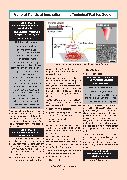General Trends of Innovation in the Technical Textiles Sector Research lines in functionalization treatments: nanotechnology Functionalization treatment (embryonic technologies): Nanotechnology Main lines of research: Sol-gel nano-finishing Thermo-chromic and photo-chromic microcapsules resistant to high temperature High durability PCMs Microencapsulation of bug repellent and natural antimicrobial products, reducing toxic biocides Drug microencapsulation in medical textiles Halogenated-free fire retardant microcapsules Kinetic control of microcapsule release of active compound Formulations of micro- and nano-capsules finishing with improved fastness New methods of application, including surface modification Determination of nanomaterials’ health and environmental impact Nanotechnology is driving a revolution in material science as for example with fiber forming polymers. This would al- low the textile sector to offer innova- tive products with new types of func- tional fibers ready to cover a large va- riety of needs. Research lines in functionalization treatments: electrospinning Electrospinning is a process in which small diameter fibers (the microfibers already mentioned) are obtained from of a polymer dissolved in an electrical- ly charged solution as a result of the application of an electric field between two electrodes. The nanofibers obtained are deposited on the surface of the collector textileImage: electrospinning process (Source: oxolutia.com) substrate, in the form of a veil or ho- mogeneous membrane of low thick- ness and weight. It is an economical and efficient meth- od for the fibers manufacturing on a micro and nanometer scale, which al- lows you to select and properly com- bine components, allowing to effective- ly adapt the fibers properties to obtain the desired morphologies and function- alities. Although the benefits of electrospin- ning still need to be improved on an industrial scale in the following aspects: •high volume processing •precision and reproducibility at all stages of manufacturing •related aspects with safety and en- vironmental Currently, several companies offer lab- oratory equipment as well as compo- nents and industrial electrospinning machinery. New technologies are expected to ap- pear in the future for the manufacture of nanofibers, becoming this one of the most important trends in the science of materials in our century. The main advantages of nanofibers obtained by electrospinning are: •Elevated surface area •High porosity NCM-OCTOBER 2021 50•High filtration efficiency •Low relative cost Functionalization treatment (embryonic technologies): Electrospinning Main lines of research: Scale-up to large volumes Precision and reproducibility during the whole manufacturing process Safety and environmental aspects By using electrospinning technologies, it is possible to design robust, light, porous and high surface area materi- als from polymer nanofibers which com- position, diameter, aspect and mor- phology can be easily and cost- effec- tively tuned. Thus, electrospinning is probably the most versatile process to produce polymer fibers from almost any polymer which can be solved or melt. Applications of these materials are cur- rently focused on biomedicine and fil- tration technologies, but the results ob- tained as materials in renewable ener- gies are very promising for near future uses. Research lines in functionalization treatments: finishing processes Regarding the finishing processes, dye-
